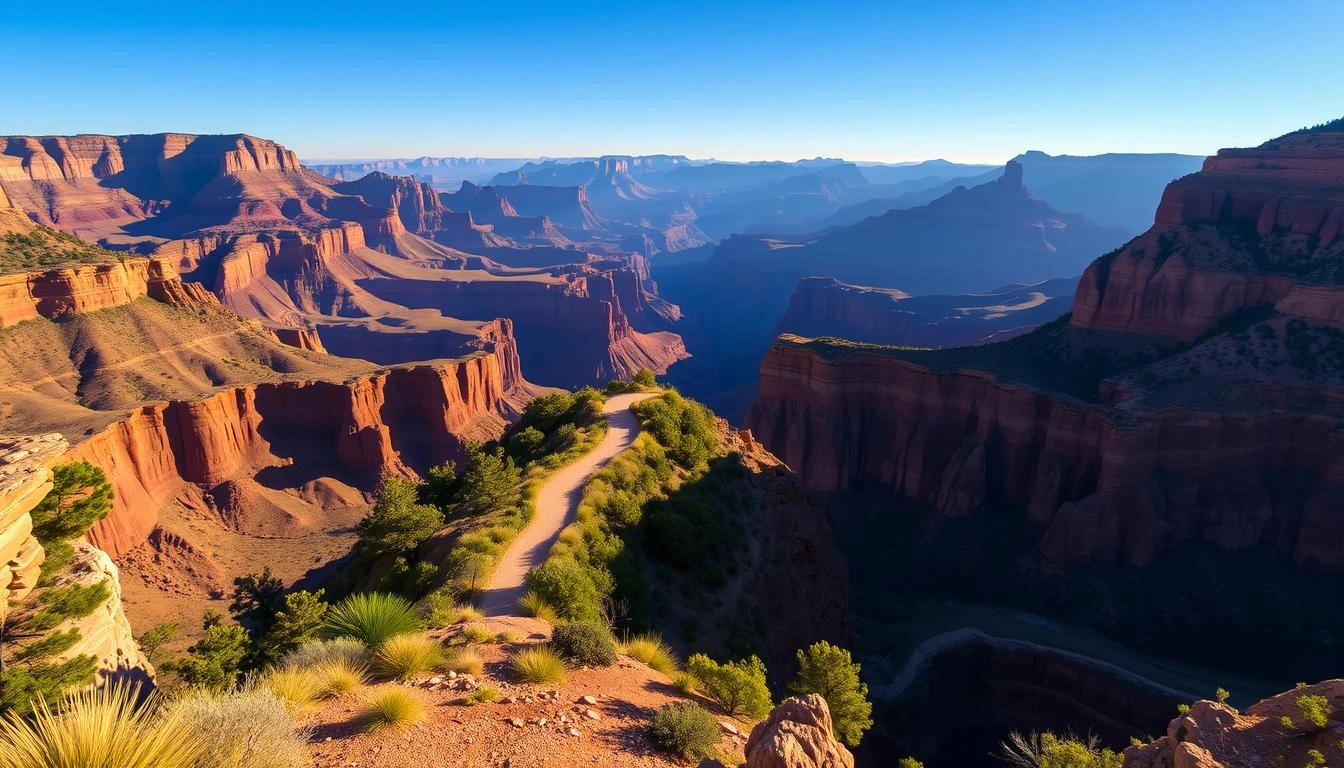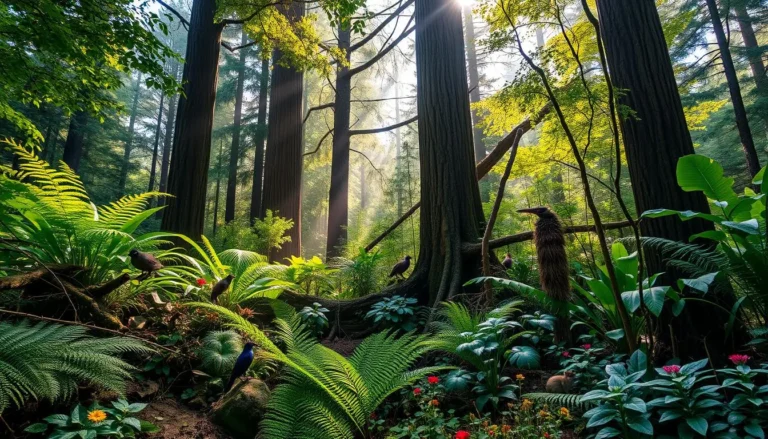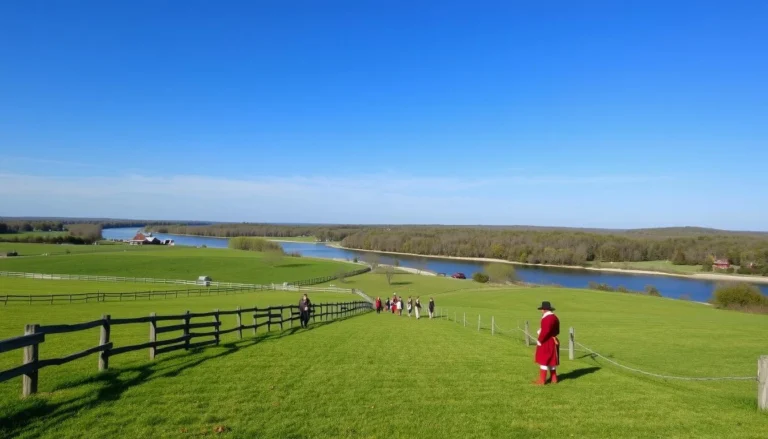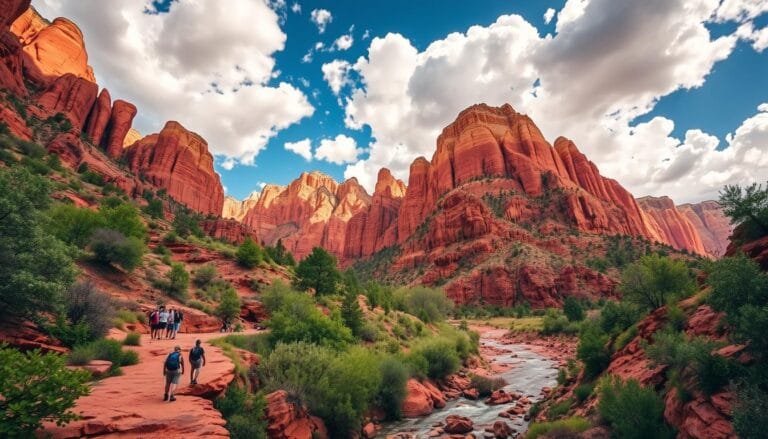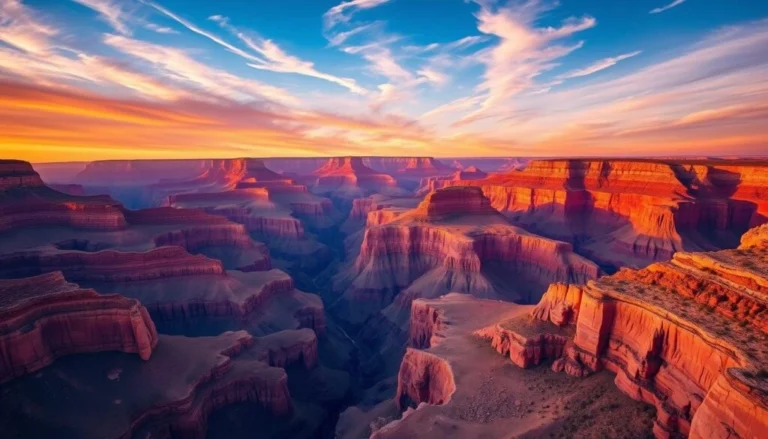Rim to Rim Grand Canyon: Ultimate Hiking Guide
Table of Contents
Introduction ; Rim to Rim Grand Canyon
Imagine standing at the edge of the Grand Canyon, looking down into its vast depths. The scale and beauty of this natural wonder are awe-inspiring. For those who love adventure and nature, the Rim to Rim hike is the ultimate experience.
This epic journey spans 21 to 24 miles across the canyon. It’s a true test of endurance and determination. Only about 1% of the 6 million visitors each year dare to try it. The hike involves over 10,000 feet of elevation change. Yet, for those who accept the challenge, it promises a life-changing adventure.
Key Takeaways
- The Rim to Rim hike in the Grand Canyon covers 21-24 miles, with a total elevation change of over 10,000 feet.
- This hike is considered extremely difficult, with less than 1% of Grand Canyon visitors attempting it.
- The recommended hiking time for the Rim to Rim trek ranges from 12 to 15 hours, including breaks.
- The best time to hike Rim to Rim is from May 15 to October 15, when the North Rim facilities are open.
- Permits are not required for individual hikers, but groups need permits for organized, non-commercial rim-to-rim hikes.
Introduction to Rim to Rim Hiking
Starting a grand canyon adventure on the Rim to Rim challenge is thrilling. This iconic hike takes you from one rim to the other. You’ll use trails like North Kaibab, South Kaibab, or Bright Angel. It’s a tough but rewarding journey with amazing views and a chance to see the canyon’s varied ecosystems.
What is Rim to Rim Hiking?
Rim to Rim hiking means going from the South Rim to the North Rim, or the other way around. You can choose from the North Kaibab, South Kaibab, or Bright Angel trails. Each trail has its own challenges and beauty. The distance varies from 20.7 miles to 43.9 miles, depending on your path.
Why Hike Rim to Rim?
The Rim to Rim challenge lets you deeply experience the canyon’s stunning views. You’ll see everything from lush North Rim forests to the dry South Rim. It’s a tough hike but gives a great sense of achievement and a memorable experience.
Best Time of Year to Hike
The best time for the Rim to Rim hike is from May 15 to October 15, when the North Rim is open. May 15-31 and October 1-15 are the best months. The weather is mild, and there are fewer people, making it a better time to hike.
“Hiking the Rim to Rim in the Grand Canyon is a life-changing experience that challenges both your physical and mental limits. The sense of accomplishment and the breathtaking views make it an unforgettable adventure.” – John Doe, avid hiker
Preparing for Your Adventure
Starting a grand canyon backpacking or rim to rim hike needs a lot of planning. You must be in good shape and pack the right stuff. Every little detail is important for a safe and fun trip.
Fitness Requirements for Rim to Rim
The rim to rim hike is very tough. It’s 23.5 miles one-way and has over 11,000 feet of elevation change. You need to be very fit to handle the long distances and big changes in height.
The hike usually takes 12 hours a day. It’s best done over two or three days. This way, you can enjoy the journey more.
Essential Gear Checklist
- Sturdy, well-broken-in hiking boots
- Trekking poles (e.g., Black Diamond Distance Carbon FLZ, Gossamer Gear LT5, Black Diamond Distance Carbon Z)
- Sun protection (hat, sunglasses, sunscreen)
- Ample water storage (at least 3 liters per person)
- Salty and sweet snacks, energy-dense foods
- First aid kit and personal medications
- Navigation tools (map, compass, GPS device)
- Warm layers (jacket, gloves, headlamp)
- Lightweight, quick-drying clothing
Food and Hydration Strategies
Good food and water are key for a successful hike. Carry at least 3 liters of water per person. Make sure to refill at water stations along the way.
Carry a mix of salty and sweet snacks. Also, bring energy-dense foods to keep your energy up.
| Trail Segment | Elevation Change | Distance | Time Estimate |
|---|---|---|---|
| North Kaibab Trail | 5,761 feet descent | 14 miles | 5-7 hours |
| Bright Angel Trail | 4,380 feet ascent | 9.5 miles | 5-8 hours |
With the right prep and safety in mind, the Grand Canyon hike is unforgettable. Plan well, pack smart, and take care of your body. This way, you’ll enjoy every moment of this amazing journey.
The Best Routes for Rim to Rim
The Grand Canyon has many trails for the famous Rim to Rim hike. Whether you’re an experienced hiker or new to exploring, knowing each trail’s unique features helps pick the right one for your adventure.
North Kaibab Trail
The North Kaibab Trail is a favorite for those looking for a tough but beautiful hike. It’s 14.2 miles long and drops 5,761 feet from the North Rim to the Colorado River. It’s a challenging hike with amazing views, testing your endurance.
South Kaibab Trail
The South Kaibab Trail is great for beginners. It’s 7 miles long and drops 4,780 feet from the South Rim. It’s known for its stunning views and is a bit easier, but be ready for the sun and open terrain.
Bright Angel Trail
The Bright Angel Trail is 9.5 miles long and drops 4,380 feet. It’s known for being more gradual and shaded. It has water sources and rest areas, making it a comfortable choice. But, it’s longer and more challenging than the South Kaibab Trail.
Each of these grand canyon trails offers a unique rim to rim routes experience. Think about your fitness, what you like in a hike, and how much challenge you want. This will help you choose the best trail for your Grand Canyon adventure.
“The Grand Canyon is one of the most awe-inspiring natural wonders in the world, and hiking Rim to Rim is a truly unforgettable experience.” – Outdoor Enthusiast Magazine
Navigating the Trail
Starting a rim to rim hike in the Grand Canyon needs careful planning. You must understand trail signs and prepare for changes in altitude. Every step requires attention to detail and safety.
Trail Markings and Navigation Tips
The Grand Canyon’s trails are easy to follow, thanks to clear signs. Before you start, get to know the trail markers and study your maps. Always check the signs and your map if you’re unsure.
Safety Precautions to Take
- Start your hike early in the morning to avoid the hottest part of the day.
- Wear a wide-brimmed hat and sun-protective clothing to shield yourself from the intense UV rays.
- Be vigilant for signs of altitude sickness, such as headaches, nausea, or dizziness, and take immediate action if you experience them.
Dealing with Altitude Changes
The Grand Canyon’s elevation changes are a big challenge. The North Rim is at 8,000 feet, and the South Rim is at 7,000 feet. Be ready for big temperature changes and how your body reacts to the altitude.
Take your time, rest often, and drink plenty of water. These steps help you safely handle the elevation changes.
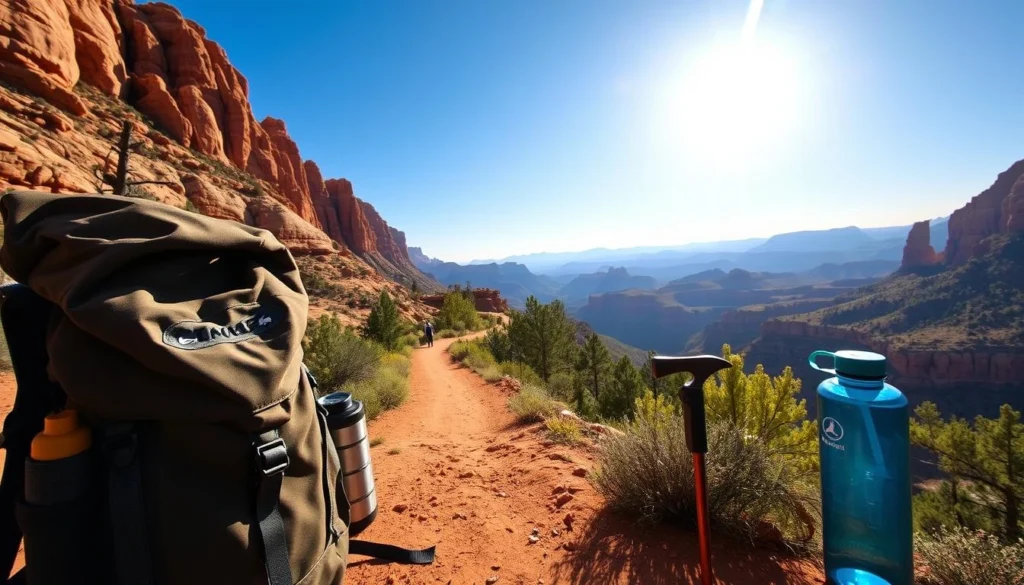
By knowing the trail signs, following safety tips, and adjusting to altitude changes, you can confidently hike the Grand Canyon’s rim to rim trails. You’ll also enjoy the stunning views along the way.
Campsites and Lodging Options
Planning your Rim to Rim Grand Canyon hike means thinking about where to stay. You might want to try tent camping or prefer the comforts of lodges. The Grand Canyon has many places to stay, fitting different needs.
Tent Camping vs. Lodges
Tent camping on the Rim to Rim trail is a unique adventure. Campsites like Bright Angel, Cottonwood, and Indian Garden offer amazing views. You’ll need a backcountry permit, which you can get through a lottery.
If you prefer a cozy stay, lodges like Phantom Ranch at the canyon’s bottom are unforgettable. But, booking Phantom Ranch up to 15 months in advance is key, as spots are very popular.
Reservation Details and Tips
For grand canyon lodging and rim to rim camping, early planning is essential. Backcountry permits are limited and given out through a lottery. Lodge bookings should be made early, especially when the canyon is busy.
Best Campsites Along the Route
- Havasupai Gardens Campground: It’s 4.8 miles below the South Rim. It has a ranger station, emergency phone, year-round water, and toilets.
- Bright Angel Campground: At the canyon’s bottom, 9.5 miles from the South Rim. It offers water, toilets, and a ranger station.
- Cottonwood Campground: 6.8 miles below the North Rim. It has seasonal water (mid-May to mid-October).
Always follow Leave No Trace principles. Be careful of the Grand Canyon’s environment when choosing your campsite or lodging.
Weather Conditions and What to Expect
Exploring the Grand Canyon means understanding its changing weather. The North Rim can be snowy, while the inner canyon is very hot. Hikers need to get ready for big temperature changes all year.
Temperature Variations by Season
Summer at the Grand Canyon is very hot, with South Rim temperatures often over 80°F. The North Rim might still have snow, with highs in the 70s. The canyon floor can be up to 30 degrees hotter, sometimes reaching 120°F.
Spring and fall are better, with South Rim temperatures between 50-70°F. The North Rim is cooler, with highs in the 60s and 70s. Spring is great for hiking, and autumn is perfect for fewer crowds.
Winter at the South Rim is cold, with highs in the 40s and lows in the teens and 20s. Snow can fall 50-100 inches a year, so hikers need to be ready for snow.
Rain and Monsoon Considerations
- The Grand Canyon gets a lot of rain during the summer.
- Thunderstorms can make trails slippery and lightning is dangerous.
- Shuttle bus service on Hermit Road might stop during bad weather, so check the forecast.
Preparing for Extremes
For a rim-to-rim hike, hikers must be ready for sudden weather changes. Wear layers, have rain gear, and know the weather forecast. This helps you stay safe and enjoy the Grand Canyon.
“The weather in the Grand Canyon can vary dramatically, from snow at the rim to triple-digit temperatures at the river. Preparation is key to ensuring a safe and enjoyable experience.”
Wildlife Encounters on the Trail
When you start your Rim to Rim hike in the Grand Canyon, get ready to see many animals. You might see bighorn sheep climbing the walls or mountain lions hiding in the dark. The Grand Canyon is full of amazing creatures that live here.
Common Animals You Might See
While hiking, look out for desert bighorn sheep, mule deer, elk, and curious rock squirrels. These animals have learned to live well in the canyon’s tough terrain and dry climate. Spotting them on the trail is a treat.
Safe Wildlife Practices
- Keep a safe distance from all wildlife. Don’t go near or feed them, as it can harm their natural ways and risk your safety.
- Keep your food and trash away to not attract raccoons or bears to your camp.
- Be mindful of your surroundings and make noise while hiking. This helps avoid surprising animals.
Conservation and Respect
The Grand Canyon’s wildlife is very special and needs our care and respect. By following Leave No Trace and being careful, we help these amazing animals stay healthy in their homes. Remember, the grand canyon wildlife and rim to rim hiking encounters are key parts of the Grand Canyon experience. Let’s treat them with wonder and respect.
“The mountains, canyons, and parks are things of beauty and wonder. They are places of recreation. But they are also places that are home to other species, and we have a moral obligation to be caretakers of this land.”
Post-Hike: Recovery and Reflection
Finishing a tough Rim to Rim hike in the Grand Canyon is a big deal. But the journey doesn’t stop when you reach the end. It’s key to recover well to heal your body and mind.
Best Recovery Practices
After your hike, drink lots of water to replace lost fluids. Try electrolyte drinks to balance your minerals. Stretch for 10-20 minutes to ease muscle pain and stiffness. Wearing compression clothes can also help with recovery.
Sharing Your Experience
Many hikers enjoy sharing their grand canyon hiking recovery and rim to rim experience. You can post photos, write in a journal, or join online hiking groups. Sharing your adventure helps keep memories alive and motivates others.
Leaving No Trace Principles
Even after your hike, keep following Leave No Trace principles. Dispose of waste properly and respect the environment. This way, you help protect the Grand Canyon for future hikers.
Reflecting on your Rim to Rim hike is vital. Acknowledge your effort, challenge yourself, and cherish the Grand Canyon’s beauty. It’s a special experience.
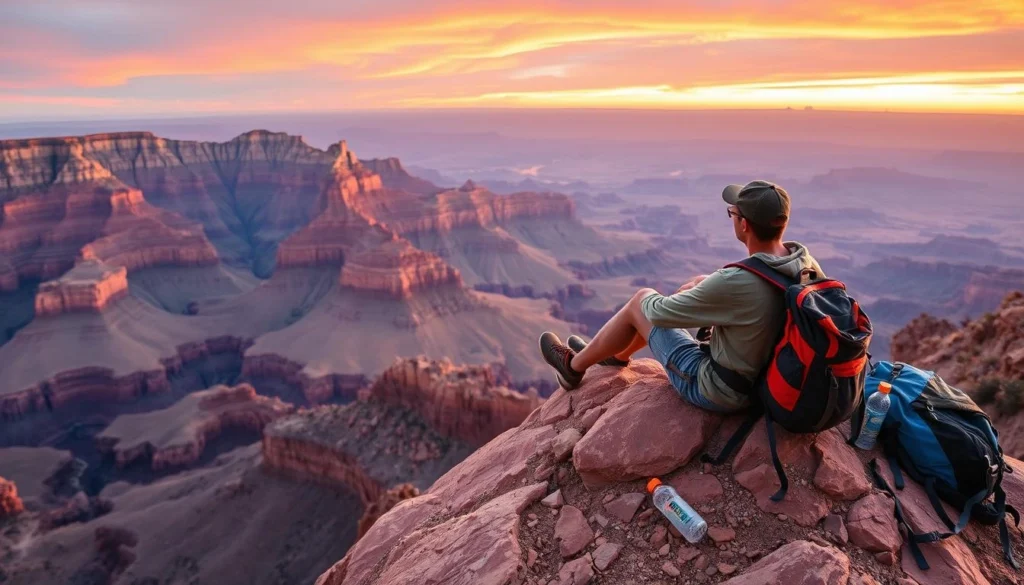
Additional Resources and Support
Getting ready for your Rim to Rim hike in the Grand Canyon? It’s key to have good resources and support. This guide is just the start. There are more ways to make your trip safe and successful.
Where to Find Local Guides
Local guides can be a big help for the Rim to Rim hike. They know the trails well and can help with planning. They also know about the Grand Canyon’s history and nature.
Recommended Books and Maps
Good guidebooks and maps are essential for the hike. Look for ones from trusted sources like the National Geographic Society. They have detailed trail info and tips to help you plan.
Online Communities for Hikers
Join online groups for Grand Canyon hikers to get advice and updates. Forums and social media groups are great for learning from others. You can ask questions and get tips for your hike.
FAQ
What is the Rim to Rim hike in the Grand Canyon?
The Rim to Rim hike in the Grand Canyon is a long journey. It spans 21-24 miles, depending on the path. This challenging trek is only attempted by less than 1% of visitors. You’ll go from one rim to the other, facing a total elevation change of 10,141-10,541 feet.
What are the best times of year to hike Rim to Rim?
The best times to hike Rim to Rim are from May 15 to October 15. This is when the North Rim facilities are open. May 15-31 and October 1-15 have the most favorable temperatures.
What kind of physical fitness and gear do I need for a Rim to Rim hike?
You need a lot of physical fitness and the right gear for a Rim to Rim hike. You should be able to handle long distances and big elevation changes. Essential items include sturdy hiking boots, sun protection, and lots of water storage.
It’s also important to have food and hydration strategies. Aim for at least 3 liters of water, salty and sweet snacks, and energy-dense foods.
What are the main trail options for Rim to Rim hiking?
There are several trails for Rim to Rim hiking. The North Kaibab trail is 14.2 miles with a 5,761 ft elevation change. The South Kaibab trail is 7 miles with a 4,780 ft elevation change. The Bright Angel trail is 9.5 miles with a 4,380 ft elevation change.
The recommended route for beginners is South Rim to North Rim via South Kaibab Trail. It’s shorter and offers amazing views.
What safety precautions should I take on the Rim to Rim trails?
Safety is key on the Rim to Rim trails. Start early to avoid the hottest part of the day. Wear a wide-brimmed hat and watch for signs of altitude sickness.
Be ready for big temperature changes between the rims and the inner canyon. Take breaks often, especially when going up steep paths.
Where can I stay while hiking Rim to Rim?
You can stay in tents or lodges while hiking Rim to Rim. There are campgrounds like Bright Angel, Cottonwood, and Indian Garden. Phantom Ranch at the canyon bottom offers lodging but needs reservations up to 15 months in advance.
Backcountry permits are needed for overnight stays. They are given out through a lottery system.
What kind of weather conditions can I expect on the Rim to Rim hike?
Weather in the Grand Canyon changes a lot from rim to inner canyon. It can snow on the North Rim and be over 90°F at Phantom Ranch. Be prepared for extreme temperature changes and possible monsoon rains in summer.
Wear layered clothes and have proper rain gear to adapt to changing weather.
What kind of wildlife might I encounter on the Rim to Rim trail?
You might see many animals on the Rim to Rim trail. It’s important to keep a safe distance and not feed them. Also, store food properly to avoid attracting wildlife to campsites.
What should I do after completing the Rim to Rim hike?
After finishing the hike, focus on recovery. Drink lots of water, stretch, and rest. Sharing your experience through photos, journals, or online forums is rewarding.
Remember to follow Leave No Trace principles even after the hike. This helps keep the Grand Canyon beautiful for others.
Where can I find additional resources for planning my Rim to Rim hike?
For more information, check out local guide services, guidebooks, and maps. Online communities and the National Park Service website are also great resources. Joining hiking groups or forums can offer support and tips from other adventurers.

